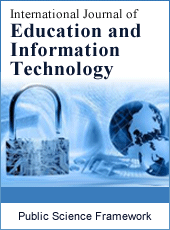International Journal of Education and Information Technology
Articles Information
International Journal of Education and Information Technology, Vol.3, No.3, Sep. 2018, Pub. Date: Aug. 31, 2018
Evaluation of Blended Computer Based Learning on the Performance of Students in Pre-Technical Skills in the Junior High Schools in Ghana
Pages: 60-72 Views: 2101 Downloads: 554
[01]
Kingsley Okyere, Department of Mathematics and Information and Communication Technology, Enchi College of Education, Enchi, Ghana.
[02]
Osei Kojo Agyeman, Department of Mathematics and Information and Communication Technology, Komenda College of Education, Komenda, Ghana.
[03]
Frank Enu-Kwesi, Department of Mathematics and Information and Communication Technology, Enchi College of Education, Enchi, Ghana.
Evaluation of blended computer based learning on the performance of students in Pre-Technical Skills is essential in today’s technological advancement. The study was conducted in the Bibiani district of the Western region. Probability sampling method (stratified and simple random sampling techniques) was used for the study. The population was made up of first year students of Central African Gold (CAG) Junior High School and Presby Junior High School. Both Schools took a Pre-test, the results of the pre-test assisted in grouping the schools into two. Central African Gold (CAG) Junior High School was selected as the Control group and Presby Junior High School as the experimental group. The experimental group was used together with traditional methods of teaching and computer software designed for the relevant topics. The statistical method used to analyse data for the study was independent-sample t-test. The level of significant chosen was 0.05. The “t” value found in the analysis of the difference between means was used to determine whether the null hypotheses concerning differences between post-test scores, and differences between the scores while controlling for pre-test scores, were to be accepted or rejected. The study revealed that students who used the blended computer based learning method performed better than those who were taught by the traditional method of instruction. It is recommended that the Ghana Education Service should offer in-service training in computer applications to teachers in our basic institutions. This will go a long way to equip them with the skills needed to design learning software in their various subjects such as that which was used in this research.
Pre-Technical Skills, Computer Based Earning, Blended Computer Based Learning, Evaluation, Junior High Schools
[01]
Agbenezer F. (2011). Personal Conversation. Islamic Junior High School. Accra.
[02]
Collis, B. (2005) ICT for Blended Learning Available at http://www.cellbiol.eu/docs/ICT_for_blended_learning_Collis.pdf
[03]
Curriculum Research and Development Division (CRDD) (2007). Teaching Syllabus for Information and Communication Technology (Primary 1-6) Accra: Ministry of Education, Youth and Sports.
[04]
Dacosta M. (2003) Lecture Notes. University of Education-College of Technology Education, Kumasi.
[05]
Dellit, J. (2002). Using ICT for Quality in Teaching - Learning Evaluation Processes. In Using ICT for Quality Teaching, Learning and Effective Management (pp. 56-66).
[06]
Driscoll, M. (2002) Blended Learning: Let’s Get beyond the Hype. IBM Global Services. http://www-07.ibm.com/services/pdf/blended_learning.pdf
[07]
Duodu A. (2011). Workshop on New Building Technology. Former Director, TVET, Ghana Education Service.
[08]
Kwan. P (2011). Personal Conversation. Bibiani: Bianco publishers.
[09]
Lall, S (1992). Technological capabilities and industrialization. World Development, 20 (2), 165-186.
[10]
NIIT (2002) Blended Learning Models. Purnima Valiathan. Instructional design specialist. NIIT.PurnimaV@NIIT.com.
[11]
Orey, M. (2002). Definition of Blended Learning. University of Georgia. Retrieved April 25th, 2017 from the World Wide Web: http://www.arches.uga.edu/~mikeorey/blendedLearning.
[12]
Quinn, C. N. (1993). Cognitive skills and computers: "Framing" the link. Proceedings of the Fifth International Conference on Thinking, Townsville, Australia.
[13]
Rooney, J. E. (2003). Blending learning opportunities to enhance educational programming and meeting, Association Management, 55 (5), 26–32.
[14]
Rossett, A. (2002). The ASTD e-learning handbook. New York: McGraw-Hill.
[15]
Singh, H., & Reed, C. (2001). A white paper: Achieving success with blended learning. Centra Software. Retrieved July 12, 2017, from http://www.centra.com/download/ whitepapers/blendedlearning.pdf.
[16]
Stockley D (2003). E- Learning definition and explanation. Retrieved from www.derekstockley.com.cu on 25th November, 2017.
[17]
Technical and Vocational Education Division (TVED), Ghana Education Service (1984) Policy Planning and Administration of Technical and Vocational Education. Unesco-1984 Technology Research and Development, 42 (2), 7–19.
[18]
Teo, T. (2007). Assessing the computer attitudes of students: An Asian perspective. Computers in Human Behaviour, 24 (4), 1634-1642.
[19]
Thomson, I. (2002). Thomson job impact study: The next generation of corporate learning. Retrieved July 7, 2017, from http://www.netg.com/DemosAndDownloads/Downloads/ JobImpact.pdf.
[20]
Tsai, M., and Tsai, C. (2003). Student computer achievement, attitude and anxiety: the role of learning strategies. Journal of Educational Computing Research 26 (1), 47-61.
[21]
Valiathan, P. (2002) Blended Learning Models. Available at: www.learningcircuits.com/2002/aug2002/ valiathan.html
[22]
Von Glasersfeld, E. (1992). Constructivism reconstructed: a reply to Suchting. Science and Education 1, 379–384.
[23]
Ward, J., & LaBranche, G. A. (2003). Blended learning: The convergence of e-learning and meetings. Franchising World, 35 (4), 22–23.
[24]
Young, J. R. (2002). “Hybrid” teaching seeks to end the divide between traditional and online instruction. Chronicle of Higher Education, 48 (28), 33-34.

ISSN Print: 2381-7410
ISSN Online: 2381-7429
Current Issue:
Vol. 5, Issue 1, March Submit a Manuscript Join Editorial Board Join Reviewer Team
ISSN Online: 2381-7429
Current Issue:
Vol. 5, Issue 1, March Submit a Manuscript Join Editorial Board Join Reviewer Team
| About This Journal |
| All Issues |
| Open Access |
| Indexing |
| Payment Information |
| Author Guidelines |
| Review Process |
| Publication Ethics |
| Editorial Board |
| Peer Reviewers |


